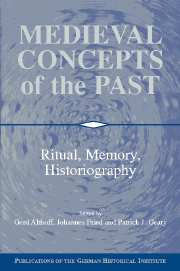Book contents
- Frontmatter
- Introduction
- 1 Authority and Legitimation of Royal Policy and Action: The Case of Henry II
- 2 King Henry II of Germany: Royal Self-Representation and Historical Memory
- 3 The Variability of Rituals in the Middle Ages
- 4 Rebels and Rituals: From Demonstrations of Enmity to Criminal Justice
- 5 Oblivion Between Orality and Textuality in the Tenth Century
- 6 Text and Ritual in Ninth-Century Political Culture: Rome, 864
- 7 The Concept of Time in the Historiography of the Eleventh and Twelfth Centuries
- 8 Constructing the Past by Means of the Present: Historiographical Foundations of Medieval Institutions, Dynasties, Peoples, and Communities
- 9 Topographies of Memory: Center and Periphery in High Medieval France
- 10 Challenging the Culture of Memoria: Dead Men, Oblivion, and the “Faithless Widow” in the Middle Ages
- 11 Artistic and Literary Representations of Family Consciousness
- 12 The Strange Pilgrimage of Odo of Deuil
- 13 The Rhineland Massacres of Jews in the First Crusade: Memories Medieval and Modern
- 14 The Martyr, the Tomb, and the Matron: Constructing the (Masculine) “Past” as a Female Power Base
- Index
14 - The Martyr, the Tomb, and the Matron: Constructing the (Masculine) “Past” as a Female Power Base
Published online by Cambridge University Press: 05 January 2013
- Frontmatter
- Introduction
- 1 Authority and Legitimation of Royal Policy and Action: The Case of Henry II
- 2 King Henry II of Germany: Royal Self-Representation and Historical Memory
- 3 The Variability of Rituals in the Middle Ages
- 4 Rebels and Rituals: From Demonstrations of Enmity to Criminal Justice
- 5 Oblivion Between Orality and Textuality in the Tenth Century
- 6 Text and Ritual in Ninth-Century Political Culture: Rome, 864
- 7 The Concept of Time in the Historiography of the Eleventh and Twelfth Centuries
- 8 Constructing the Past by Means of the Present: Historiographical Foundations of Medieval Institutions, Dynasties, Peoples, and Communities
- 9 Topographies of Memory: Center and Periphery in High Medieval France
- 10 Challenging the Culture of Memoria: Dead Men, Oblivion, and the “Faithless Widow” in the Middle Ages
- 11 Artistic and Literary Representations of Family Consciousness
- 12 The Strange Pilgrimage of Odo of Deuil
- 13 The Rhineland Massacres of Jews in the First Crusade: Memories Medieval and Modern
- 14 The Martyr, the Tomb, and the Matron: Constructing the (Masculine) “Past” as a Female Power Base
- Index
Summary
The vitality of a culture or ideology depends upon its ability to channel the power of such mordant symbols as the corpse.
The Figure of the Martyr as an Historical Representation
This chapter discusses the gender dynamics surrounding one particular memorial practice: the cult of martyrs. Human decisions in the present are often influenced by beliefs concerning what has happened in the “past.” Therefore, control over representations of the past can be a source of influence in society. Furthermore, when the medium for representation of the past is the shrine tomb of a saint, the person who controls the monument (the place of memory) benefits from an additional source of power, in that holy corpses have been widely perceived as instrumental in the production of miracles. Memorial practices connected with martyr cults involved construction in two senses: construction of the “past” in the guise of remembering it and construction of a physical shrine.
First, a few words about martyr cults in general. An indeterminate number of Christians were executed by Roman imperial authorities before the conversion of Emperor Constantine to Christianity early in the fourth century and his subsequent legalization of the new religion in 313. Before the fourth century, Christians certainly cared about the fate of the remains of their executed relatives and friends, but (with extremely rare exceptions) neither established cults in their memory nor expected supernatural powers from them. Yet, the fact that cults were eventually rendered to those “martyred” individuals tends to be treated by scholars as self-explanatory and even inevitable. Scholars have focused instead on explaining the roots of the act of martyrdom and the theological rationale for martyrdom; meanwhile, general surveys of the veneration of saints skim over the development of martyr cults on the apparent assumption that little explanation or analysis is required.
- Type
- Chapter
- Information
- Medieval Concepts of the PastRitual, Memory, Historiography, pp. 311 - 342Publisher: Cambridge University PressPrint publication year: 2002



